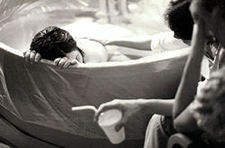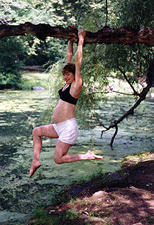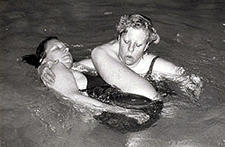
PREPARATION
First, ask some questions about yourself:
How did you decide on a waterbirth? Was this a decision you came to on your own? Who else impacted your decision for a waterbirth? How did they impact your decision?
Picture yourself laboring and giving birth immersed in water. What about this picture comforts you and what about this picture makes you uncomfortable? How do you feel about nudity? You do not necessarily need to be nude in the tub; it is possible to wear a large t-shirt. Which scenario makes you most comfortable?
Then think about how you might react to various situations:
Plan for the possibility of a birth different from your current expectations. Are you comfortable releasing some control? It is key to remain flexible. Prepare yourself mentally to go with your instincts at the time and to accept the decisions you make during the birth. For instance, think about how you might feel if the baby was not born into water or if you decided to get out of the tub before the actual birth.
The actual birth may not play out exactly like your carefully constructed birth plan. Make sure that you are mentally prepared for this possible reality. Also, let the person/people who will support you throughout labor know not only of your birth plan, but also of your desire and "alternate" plan to go with your instincts.
Personal and practical preparation of body/mind/spirit:
Spend time in the water, swimming for fun, or join a water exercise class. Mothers have greater mobility, increased endurance, feel virtually weightless, stay cool, feel a decrease in fluid retention and feel better emotionally. It is also a great networking environment.(Work out three times a week for 45 minutes) Go solo or bring your partner or a friend.
Discover where "watsu," a specialized water massage is offered. Often times during a "watsu" session, reframing and releasing of past birth trauma can result from a session with a trained practitioner.
Feel free to engage in nightly warm, not hot baths. Light some candles; drop in 8 drops of lavender essence oil. Massage your belly and breasts with pure almond oil. Talk to your baby. Prenatal bonding is as important as postnatal bonding.
It is important to identify your fears about labor and birth. Educate yourself by gathering as much BALANCED information as possible. Examine the various viewpoints and various "sides" to an issue. Read books and articles, watch videos of actual births, peruse the Internet and talk to people you trust. Set-up a consultation with a waterbirth consultant. Finally, make sure that your birth attendant (whether a midwife or a physician) and labor support people are both supportive of and knowledgeable about waterbirth.
Finally, make the necessary preparations:
 Hospital
Policies/Procedures If you plan to give birth in a hospital, make
sure you start the process of inquiry very early and that you are
well informed of the necessary steps to preparing and arranging
for a waterbirth in a hospital setting. First, research individual
hospitals. Which hospitals will permit the baby to be born into
water? Some hospitals permit women to labor in water, but not to
give birth into water. Make sure you are clear on hospital policies
regarding birth into water. Contact the nurse manager or perinatal
coordinator of the hospital. Send written inquiries to individual
hospitals about their respective policies and procedures pertaining
to waterbirth.
Hospital
Policies/Procedures If you plan to give birth in a hospital, make
sure you start the process of inquiry very early and that you are
well informed of the necessary steps to preparing and arranging
for a waterbirth in a hospital setting. First, research individual
hospitals. Which hospitals will permit the baby to be born into
water? Some hospitals permit women to labor in water, but not to
give birth into water. Make sure you are clear on hospital policies
regarding birth into water. Contact the nurse manager or perinatal
coordinator of the hospital. Send written inquiries to individual
hospitals about their respective policies and procedures pertaining
to waterbirth.
In planning for a hospital-based waterbirth, you will need to send letters to various hospital administrators and you will want a hospital-sanctioned professional who will act as your primary birth attendant to support your request. Your letters should include a clear description of your request and a clear-cut plan for set-up and implementation. If possible, set up a face-to-face meeting with the people to whom you've written. Better yet, try and organize a joint meeting.
Connect with various organizations that support waterbirth. Ask for research packages regarding sample protocols, pool kit, videos, books, waterbirth conference material or other supportive literature. (See websites)
Renting A Tub/Getting the Necessary Supplies
Speak with your birth attendant about renting a tub. She will likely be able to provide you with names of people and organizations for tub rentals. Some midwives or labor support doulas even rent them themselves.
Make sure you have the additional necessary supplies:
It is recommended by some to purchase two hoses, each in a different color, one for filling and one for emptying the tub. One new hot water hose will be sufficient if you are not going to be filling and draining the tub throughout the labor. If you need to take some water out, get a clean bucket or two and manually remove the water and replace through the hose. Buckets are also great for the caregivers to sit on outside the tub.
Everyone must drink fluids consistently throughout the labor and birth, especially the mother. Make sure there are sugars or glucose in theespecially the mother. Make sure there are sugars or glucose in the fluids. Dilute juice with water. Make a "labor tea" with red raspberry leaf, blessed thistle, nettles, dandelion, fennel and add honey or rice syrup. Dilute with water. Even though the room has a tub full of water, it will also dehydrate those in the room, so it is important for all to drink.
Preparing the Tub
 It
is always a good idea to do a test-run. Shortly after you get the
tub; see how long it takes to fill it to the desired capacity. This
will help you gauge at what point during labor to start filling
the tub. Remember to prepare accordingly, the water will go up about
1" to 2" for every person who gets in the tub.
It
is always a good idea to do a test-run. Shortly after you get the
tub; see how long it takes to fill it to the desired capacity. This
will help you gauge at what point during labor to start filling
the tub. Remember to prepare accordingly, the water will go up about
1" to 2" for every person who gets in the tub.
If you are planning on having your partner and/or support person in the tub with you, fill the tub accordingly. Ideally you'll want the water to reach the shoulders. The temperature should not exceed body temperature, which is approximately 98 degrees F and 37 degrees C (maternal temperature). Just as the test-run is important for filling the tub, it is also important for emptying the tub as there will be a lot of water.
If you are going to be bringing the tub to a hospital or birth center environment, perform a "test set up" in your home. Don't fill the tub with water because the water pressure will be different in the medical facility. If the tub is inflatable, clean the tub yourself so you know everything has been as sterilized as possible. Clean the tub with a quaternary ammonium solution. If you are at home with jets, after you clean the tub with the solution, refill the tub with water and add some brominating agent to circulate through the jet system for a minimum of ten minutes. (Hospitals report that a half-cup of powdered dishwashing crystals such as Cascade works fine.)
When cleaning the tub and storing it, make sure the tub pieces have been cleaned and wiped thoroughly dry before packing into the boxes.
Finally, remember that women have successfully given birth for centuries -- women's bodies have built-in mechanisms that enable them to give birth. Always trust your body, trust your baby and surrender yourself to flowing in the moment
